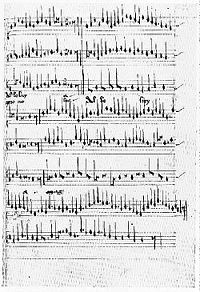
Pepys Manuscript
Encyclopedia

England
England is a country that is part of the United Kingdom. It shares land borders with Scotland to the north and Wales to the west; the Irish Sea is to the north west, the Celtic Sea to the south west, with the North Sea to the east and the English Channel to the south separating it from continental...
choirbook
Choirbook
A Choirbook is a large format manuscript used by choirs in churches or cathedrals during the Middle Ages and Renaissance. The book is large enough for the entire choir to read from one book. Often for polyphonic works all the musical parts or voices of a piece of music are presented on a single...
. Along with the Ritson Manuscript
Ritson Manuscript
The Ritson Manuscript is a late fifteenth-century English choirbook. Along with the Pepys Manuscript it is much less elaborate than the Eton, Lambeth and Caius Choirbooks; it contains shorter and simpler pieces which appear to have been written for smaller and less able choirs...
it is much less elaborate than the Eton
Eton Choirbook
The Eton Choirbook is a richly illuminated manuscript collection of English sacred music composed during the late fifteenth century. It was one of very few collections of Latin liturgical music to survive the Reformation, and originally contained music by 24 different composers; however, many of...
, Lambeth
Lambeth Choirbook
The Lambeth Choirbook is an illuminated choirbook dating to the sixteenth century and containing much music by Tudor-period composers. The major contributors are Robert Fayrfax and Nicholas Ludford; between them they contributed at least ten of its nineteen pieces...
and Caius Choirbook
Caius Choirbook
The Caius Choirbook is an illuminated choirbook dating to the early sixteenth century and containing much music by Tudor-period composers. The book appears to originate from Arundel in Sussex, and to have been created sometime in the late 1520s; the then Master of Arundel College, Edward Higgons,...
s, it contains shorter and simpler pieces which appear to have been written for smaller and less able choirs. The book received its name because it was part of the collection owned by Samuel Pepys
Samuel Pepys
Samuel Pepys FRS, MP, JP, was an English naval administrator and Member of Parliament who is now most famous for the diary he kept for a decade while still a relatively young man...
. He described it as containing "monkish music of Edward IV
Edward IV of England
Edward IV was King of England from 4 March 1461 until 3 October 1470, and again from 11 April 1471 until his death. He was the first Yorkist King of England...
's time, " but it appears on internal evidence to have been begun a year or two earlier. It was likely completed after 1465, as it contains music ascribed to Sir William Hawte
William Hawte
Sir William Hawte was an English composer about whom little is known. He was knighted in 1465, and is represented in a number of manuscript choirbooks that survive to this day...
- also referred to as a "Knight" - who was knighted in that year.

